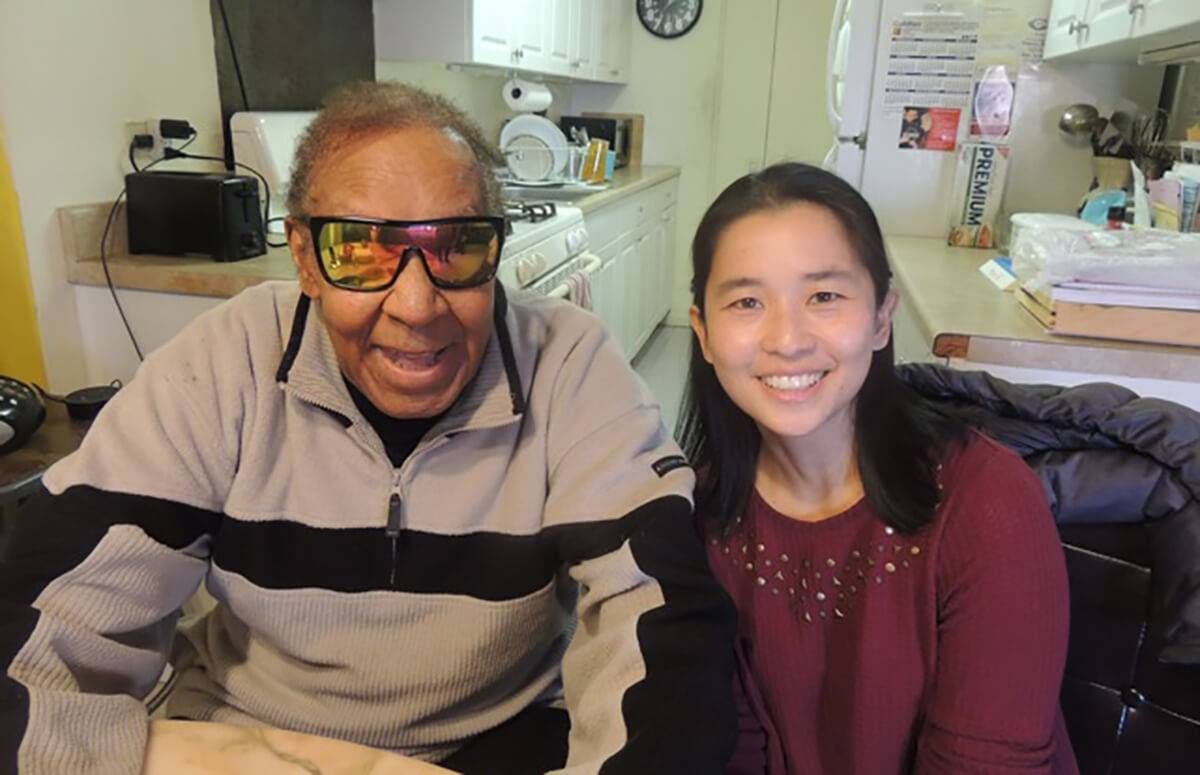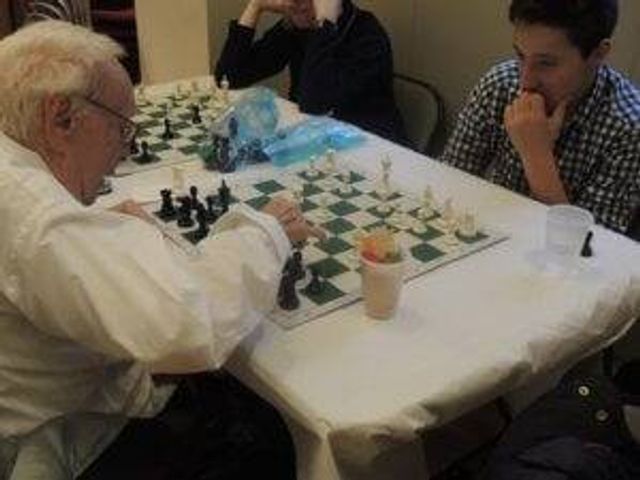New York City Program Brings Generations Together
Making connections with young people at DOROT keeps loneliness at bay
A large room fills with older adults and teenagers in the New York City headquarters of the nonprofit DOROT. They sit down on opposite sides of two long rows of tables filled with black-and-white chess sets.

Dressed in a sweatshirt and jeans, Jessica Nooney, who says she is “almost 80,” plays with Joelle Garcia, 15. Nooney learned chess as a child from her father.
“I’ve always loved to play, and I’m so happy to play with young people,” she says. Unlike when she was raising her teenage children, she says, “It’s a different relationship when you don’t have to be the authority figure. It’s a great idea to have intergenerational chess.”
“I agree,” says Garcia.
“So it’s my move?” asks Nooney, eager to return to their game.
Intergenerational chess is one of many programs organized by DOROT, which means “generations” in Hebrew. It was founded by Columbia University graduates in 1976 as a way to promote social engagement and reduce loneliness among older adults, particularly through intergenerational programming.

Connection Between the Generations Is Key
“Social isolation has devastating consequences,” says DOROT Executive Director Mark Meridy, citing recent studies that find loneliness and isolation can contribute to high blood pressure, dementia and decreased longevity, among other ills. DOROT recently hired a research director to measure the group's impact on reducing isolation.
Housed in an impressive five-story building on the Upper West Side, the organization annually serves some 3,000 older people, 70 percent of them Jewish, who live independently in New York City and Westchester County.
In addition to 60 staff members, 7,000 volunteers of all ages participate. High school and college students are also awarded internships to engage in high-quality intergenerational programs; hundreds more students apply than can be accepted. In 2017, DOROT won the prestigious Eisner Prize for Intergenerational Excellence.
What began as volunteers bringing food to older people has grown to include a telephone-based University without Walls for those who are homebound; transitional housing for homeless older adults; a legacy program for people to share and preserve their stories; a friendly visitor program; exercise classes and intergenerational chess, baking and arts classes, among many others.
Activities are free or have a suggested donation, regardless of income.
Match-Making
To connect older and younger people in meaningful ways, DOROT social workers look for commonalities between individuals, whether a shared interest or similar background. Volunteers make a one-year commitment, for either weekly or monthly visits. The average volunteering tenure is three years, but some last far longer.
“Our whole perspective is training and assisting young people to be good, effective volunteers,” says Meridy. “Regardless of age, you have to go through orientation.”
One extraordinary "friendly visitor" match: Ramon Couzon, 78, and Vera Ruangtragool, 34. Sitting at Couzon’s kitchen table, the two shared their story.
In 2015, Couzon was grieving the loss of his wife of 30 years, whom he had cared for during the last two years of her life. That's when Ruangtragool, a DOROT volunteer, delivered a package of food and stayed to visit.
“You felt like you were on your own,” Ruangtragool told Couzon. “You said, ‘How do I learn to live and be completely by myself?’” Ruangtragool said she found meditation transformative and a way to find peacefulness.
Friendly Chats and Meditation
From there, a friendship grew. Ruangtragool comes to visit Couzon weekly and the two chat before doing a 40-minute guided meditation.
“I never had the opportunity to do meditation,” Couzon says. “It was really helpful at this time when my whole world had fallen apart.”
In his younger years, Couzon was a competitive dancer and a “show biz” manager. His spare apartment has a grand piano and congo drums.
He shared the painful story of his wife’s death and his unwillingness to let her go. “When I got with Vera, I needed to learn how to live again,” Couzon said. “What do I do for an encore? Now I dig deep within myself and find peace through her tutorship.”
Ruangtragool added that the relationship has helped her as well. “It allows me to have a more complete view of the human experience,” she said. Not only is there the satisfaction of being of service, but by knowing Couzon, her view of growing old has expanded.
“It makes me more hopeful,” she said.
A Worthy Competitor
Another special match has been Zachary Targoff, 17, and Herman Bomze, now in his 90s. When Zachary was 12, he was looking for a service project as part of his bar mitzvah year. He learned about DOROT’s friendly visitor program.
“I didn’t like the idea of just visiting for an hour,” he said. DOROT matched him with Bomze, who, like Zachary, was an avid chess player.
Zachary started playing chess when he was 3. He was playing in tournaments by age 5 and beating his father at the game by age 8. But with Bomze, then 89, he met his match.
“It was fantastic,” said Zachary. “He was incredibly skilled, and I was losing to him.” One thing he learned from Bomze was patience, because, Zachary said, "he took a very long time to play.” He also learned of Bomze’s story — fleeing Vienna during World War II and his father’s death in a concentration camp.
Bomze showed Zachary a Polish wooden chess set with hand-carved pieces that Bomze’s father gave him when he was 6. He gave Zachary the precious chess set for his bar mitzvah.
Zachary’s friendship with Bomze was so meaningful that he, his parents and DOROT went on to organize the intergenerational chess program, funded with Zachary’s bar mitzvah gifts and his parents’ donations.
Playing chess with an older person is “a great experience,” he said. “A lot of kids don’t have anything like this in their lives.” To him, there is a “spiritual aspect. You have a sense of doing a good deed, of helping someone else.”
The Chance to Reflect and Explore
One of DOROT’s newest offerings is a legacy program called Lasting Impressions. “Lasting Impressions was created to help older adults share their important memories, beliefs and values, and hopes for the future,” said its program director, Wendy Handler. “The idea is that the process of reflection is helpful to the individuals sharing their memories, but also a wonderful legacy to leave and very beneficial to the person privileged enough to hear the stories as they’re being told.”
Activities have included opportunities for teens to hear stories from World War II veterans and Holocaust survivors and to create projects based on what they learned.
An Antidote to Estrangement
Viviane Topp, 70, participates in Lasting Impressions and many other programs. Estranged from her daughter and with no contact with her grandchildren, she came to DOROT hoping to connect with others, especially kids.
Now, Topp has a friendship with a teenage girl through DOROT. Among the intergenerational offerings she has enjoyed are ceramics, a theater program and a class where older adults and 11-year-olds learn to cook traditional Jewish dishes. She was looking forward to an upcoming autobiography class, despite her fear of writing.
“DOROT is helping me accept myself,” she said. “I feel safe coming to DOROT. You’re not judged. All the programs have been so impactful, so meaningful. And it’s fun.”
This is the second of a three-part series on model intergenerational programs. The series is written with the support of a journalism fellowship from New America Media, the Gerontological Society of America and AARP.

